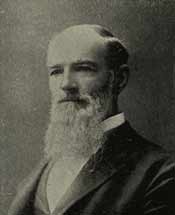DeWitt Clinton Cregier
DeWitt Clinton Cregier (June 1, 1829 - November 9, 1898; buried in Rosehill Cemetery) served as mayor of Chicago, Illinois (1889–1891) for the Democratic Party. Prior to this he was an engineer with the City of Chicago, and was awarded, in 1875, U.S. Patent 164,149 and in 1876, U.S. Patent 173,768, both for fire hydrants. The latter was a combination drinking fountain, fire hydrant, and watering basin for animals. The Cregier hydrant is widely seen in old photographs of Chicago.
DeWitt Clinton Cregier | |
|---|---|
 | |
| 31st Mayor of Chicago | |
| In office April 15, 1889 – April 27, 1891 | |
| Preceded by | John A. Roche |
| Succeeded by | Hempstead Washburne |
| Personal details | |
| Born | June 1, 1829 New York City |
| Died | November 9, 1898 (aged 69) Chicago, Illinois, United States |
| Political party | Democrat |
| Height | 5 ft 7 in (170 cm) |
| Spouse(s) | Mary Sophia Foggin |
| Children | Ten (2 daughters, 8 sons) |
| Residence | Chicago and St. Charles, Illinois |
| Website | Wikipedia, Chicago Public Library |
Cregier was also Master Mason, presided as Worshipful Master of Blaney Lodge No. 271, A.F. & A.M. of Illinois for eight years, and served as Grand Master of Illinois in 1870-1871. D.C. Cregier Lodge No. 81 in Wheeling, Illinois, is named after him. He was a fifth great-grandson of Martin Cregier, first Burgomaster of New Amsterdam.[1]
Creiger served as the chief engineer of the Chicago water system, and subsequently as Chicago's Commissioner of Public Works during the first mayoralty of Carter Harrison Sr. [2] Creiger came into conflict with Harrison when Creiger's own ambition to someday become mayor became apparent.[2]
Cregier won the 1889 Chicago mayoral election. He was sworn in as mayor on April 15, 1889.[3]
As mayor, Cregier, alongside former Illinois Central Railroad president Edward Turner Jeffery and businessman Thomas Barbour Bryan, delivered the presentation for Chicago's successful bid to the fifteen member United States Senate committee that decided what location would be awarded the World's Columbian Exposition.[4]
Cregier lost his bid for reelection in the 1891 Chicago mayoral election. He had first seen Carter Harrison Sr. challenge him for the Democratic nomination. Cregier was able to win renomination over Harrison, as the local Democratic political machines had supported Cregier as they found him to be even more accommodating to them than Harrison had been.[5] However, he lost the general election in a four-way race, placing third behind Republican nominee Hempstead Washburne and Carter Harrison Sr., who ran as an independent Democrat.
Cregier's tenure as mayor ended on April 27, 1891.[6]
Biography entitled: "The New York Orphan Who Built Chicago" subtitled: "The Story of DeWitt Clinton Cregier A 19th-Century American Engineering Genius" published October 2011, author Gloria Cregier Emma, one of Cregier's last surviving two grandchildren. Book available at public libraries and history museums in Chicago and suburban areas, in Springfield, Illinois, and by contact with author in Geneva, Illinois.
See also
References
- "Wheeling Freemasons". www.facebook.com. Retrieved Aug 8, 2020.
- Lindberg, Richard C. (2009). The Gambler King of Clark Street: Michael C. McDonald and the Rise of Chicago's Democratic Machine. SIU Press. p. 153. ISBN 978-0-8093-8654-3. Retrieved 19 May 2020.
- "Mayor DeWitt Clinton Cregier Inaugural Address, 1889". www.chipublib.org. Chicago Public Library. Retrieved 26 May 2020.
- Wilson, Nancy (2013). "EHM HISTORICAL HIGHLIGHTS Thomas Barbour Bryan (1828 – 1906)". emhurst.org. Elmhurst History Museum. Retrieved 8 May 2020.
- Miller, Donald L. (2014). City of the Century: The Epic of Chicago and the Making of America. Rosetta Books. p. 732. ISBN 978-0-7953-3985-1. Retrieved 23 May 2020.
- "Mayor Hempstead Washburne Inaugural Address, 1891". www.chipublib.org. Chicago Public Library. Retrieved 26 May 2020.
External link
